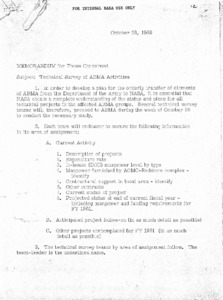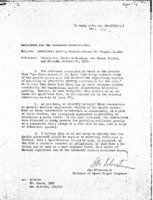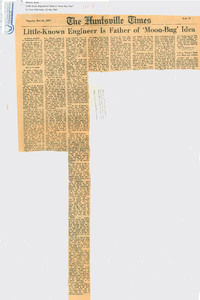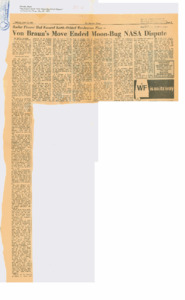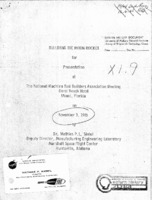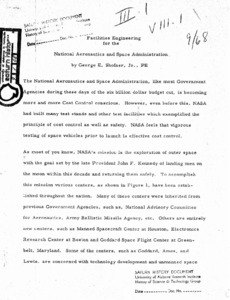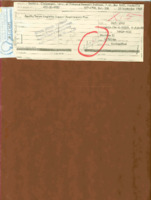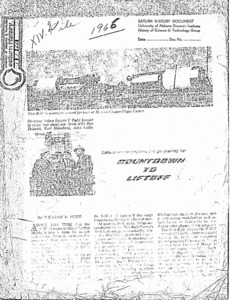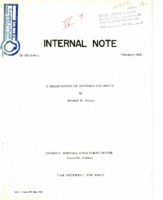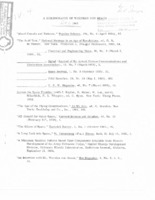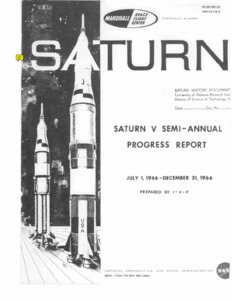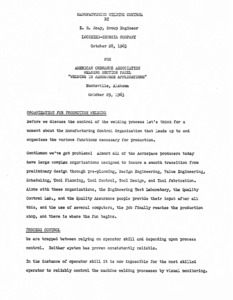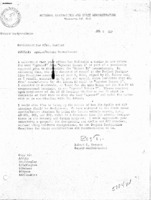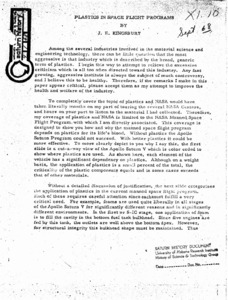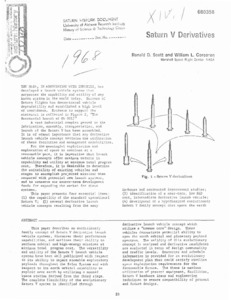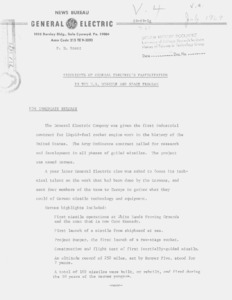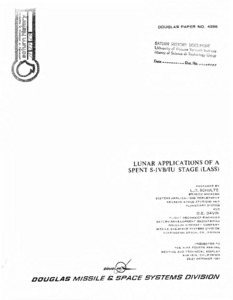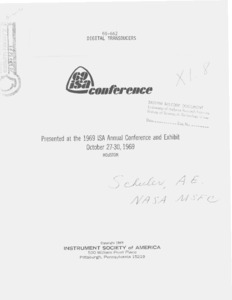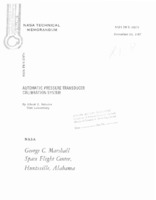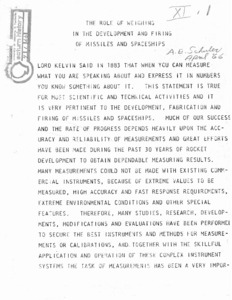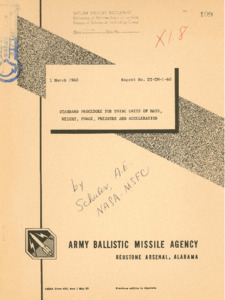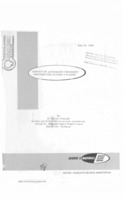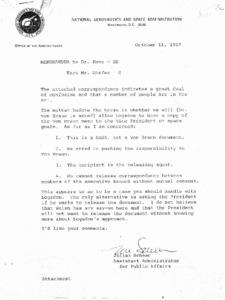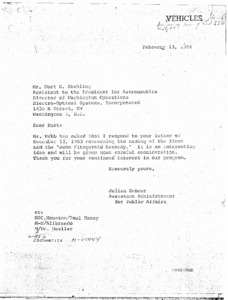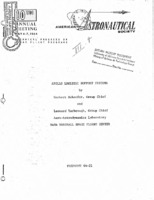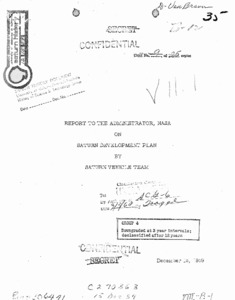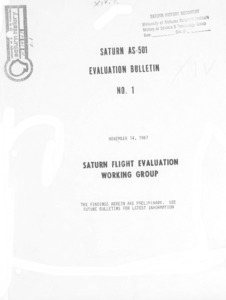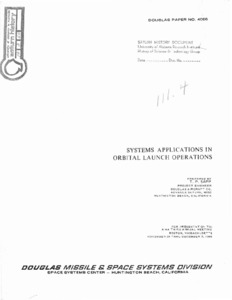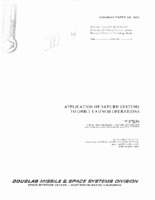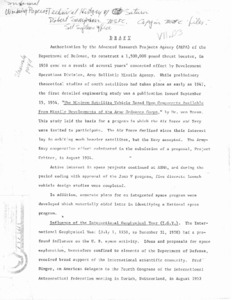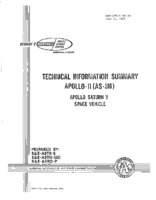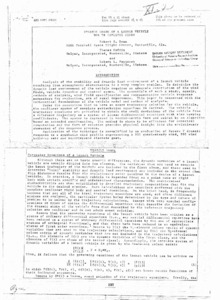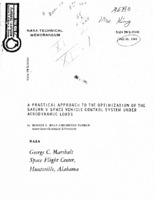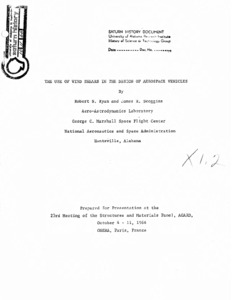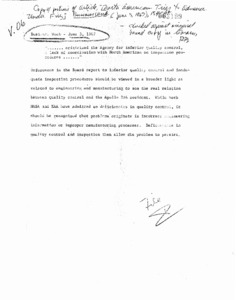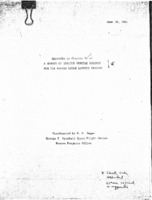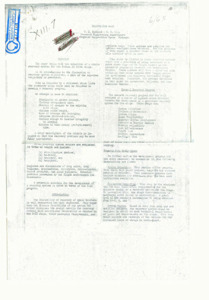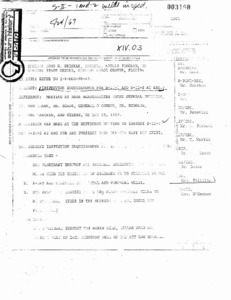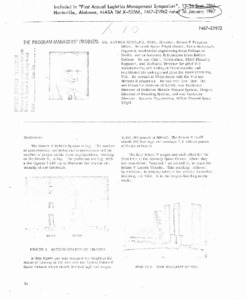
Browse Items (970 total)
Sort by:
-
"Technical survey of ABMA activities."
Handwritten notes on the document.; Archive copy is a poor photocopy. -
"Memorandum for the Associate Administrator: Artificial Gravity Considerations for Project Apollo."
This memorandum contains artificial gravity considerations for Project Apollo and was directed to Seamans, Wernher von Braun, Donlon, and Gilruth. Silverstein writes that he believes it is too early to tell if the Apollo spacecraft is capable of providing artificial gravity. -
"Little known engineer is father of 'Moon-Bug' idea."
News article that details the creation and function of a lunar module or "moon bug" created by Wernher von Braun. -
Draft of "Building the Moon Rocket."
"Building the Moon Rocket" was presented at the National Machine Tool Builders Association Meeting, Doral Beach Hotel, Miami, Florida on November 3, 1965 by Dr. Mathias P.L. Siebel, the Deputy Director, Manufacturing Engineering Laboratory. There are handwritten notes throughout. -
"Management problems faced in making future manned space exploration decisions."
This paper presents in synoptic form, an analysis of the management problems being faced in making fuhlre manned spaceflight decisions. It is an attempt to view the manned space program in total perspective - its relationship to other scientific research, other national programs, the role of Congress, the President's role, industry's role, and then show their relative influence and impact on decisior, making for the Post-Apollo period. -
"Facilities Engineering for the National Aeronautics and Space Administration."
Article makes references to a film. Centers around the idea that testing space vehicles extensively before launch is cost control. -
Memorandum to update the "Apollo/Saturn Logistics Support Requirements Plan."
This memorandum contains the pages to be changed in the logistics program for the Apollo/Saturn Project. The logistics plan includes the design, procuring, manufacturing, and production processes. This plan formalizes the program, improves logistic support, and implements management and action plans. -
"Countdown to Liftoff".
This is an article from the Boeing Magazine. The Archive copy is a very poor photocopy and is difficult to read.; About the time the S-IC-1 booster is lifting the first Apollo/Saturn V from the launch pad on its maiden unmanned flight next year, a Boeing systems test crew will begin static testing the S-IC-4 at Devils Swamp, Mississippi (MTF). Starting with S-IC-4, all Saturn V first stage boosters will be captive fired at MTF. At present, S-IC firings are conducted by MSFC's test laboratory at Huntsville. The first flight stage, the S-IC-1, was placed in the static test stand on 24 January 1966 and completed its test program 25 Feb. It was removed from the stand March 14 and is undergoing post-firing checkout. it is due to be shipped this summer to KSC where it will be mated to the two upper stages of Saturn V, the IU and Dummy Apollo payload. The S-IC-2 went into the static stand on March 22 and is being tested during April The S-IC-3 also will be tested at Huntsville in 1966. The job of putting the world's largest and most powerful rocket together will be accomplished in the world's largest building, the 52-story vehicle assembly building. -
"A Bibliography of Wernher von Braun."
The document is designated for internal use only. -
"Saturn V semi-annual progress report July-December, 1966."
MA-001-00202H.; MPR-SAT V 66-3.; ABSTRACT: This Saturn V Semi-Annual Progress report describes progress and major achievements from July 1, 1966, through December 31, 1966, in the Saturn V Program. -
"Manufacturing welding control by E. R. Seay, Group Engineer, Lockheed-Georgia Company."
Paper given at the American Ordnance Association Welding Section Panel. Focuses on the process of welding and development programs. -
Memorandum for Dr. Mueller from Robert C. Seamans.
This memorandum details changes or changes to be considered in Apollo-Saturn nomenclature. It also contains the matter of the Apollo and AAP missions designs and changes Seamans wishes to see. -
"Planning for strategic deterrence in the 1970s."
Article discussing money-resources and the budget. -
"Saturn V derivatives."
This paper desciibes an evolutionary family concept of !h turn V derivative launch vehicle systems, discusses their performance capabilities, and outlines their ability to perform orbital and hlgh-energy missions at minimum total program cost. -
"Highlights of General Electric's Participation in the U.S. Missile and Space Program."
Press release covering the system of functional management in NASA. -
"Lunar Applications of a Spent S-IVB/IU stage (LASS)."
Support of lunar exploration missions is a major consideration in future space program planning. The spent Saturn v/S-IVB/IU can support both lunar - orbit and lunar -landing operations. This paper investigates lunar applications of the spent stage, and incorporates data generated during Company-funded studies. Investigated here is the feasibility of using a launch vehicle employing standard S-IC and S-I1 boost stages to deliver a modified S-IVB/IU and large discretionary payloads to a lunar orbit (LASSO) and/or the lunar surface (LASS). Operations in Earth orbit and direct-ascent trajectories are examined, and consideration is given to the use of the spent stage as a shelter in a manner similar to the presently planned Earth orbital workshop operations. Both the LASSO and LASS concepts are recommended for consideration in future lunar exploration plans. These concepts are capable of placing a gross wet weight of 101,400 lb in lunar orbit or landing 63,580 lb on the lunar surface respectively. The effective payload capability can be enhanced by proper integration of translunar mission subsystems with the subsystems required for lunar orbit or surface operations. The vehicles can be available within 3 years, with current-technology hardware sufficient for performing the missions described.; Douglas Paper No. 4256. -
"Digital Transducers."
This paper outlines the major advantages of digital transducers and describes the principles and features (1) direct digital transducers, (2) indirect digital transducers, (3) quasi-digital transducers, and (4) A to D transducers. -
"Automatic Pressure Transducer Calibration System."
The abstract notes, "The development of an automatic pressure transducer calibration system is discussed in this report. Evolution from past practices and systems into an automatic calibration system with computerized data handling is described." -
"The role of weighing in the development and firing of missile and spaceships."
Speech regarding the importance of developing and upgrading space ships and space technology. -
"Standard procedure for using units of mass, weight, force, pressure and acceleration."
Report No. DT-TM-1-60. ; FORWARD: The field of missiles and rockets deals with quantities of matter at various locations with different accelerations of gravity. The weight of these masses changes with gravity and the measurements of liftoff weight, fuel weight, etc., result in different values, depending on whether mass or weight units are used. Pressure and thrust are independent of the acceleration of gravity, but the instruments for measuring these values are calibrated with standard masses, producing different weight forces and calibration curves at different locations. Most sections of ABMA and other agencies or companies use pounds or kilograms as units of mass, weight or force, and the influences of different accelerations of gravity are often disregarded or treated incorrectly. These discrepancies become increasingly unacceptable with larger missiles and greater distances between operation sites. Therefore, the following Standard Procedure has been prepared to insure consistent and uniform terms and units of mass, weight, force, pressure and acceleration. All sections and individuals concerned are urged to use these units andprocedures. This is signed by Dr. Wernher von Braun, Director Development Operations Division. -
Survey of Automatic Checkout Systems for Saturn V Stages.
The Abstract states "The four checkout systems developed and utilized by the National Aeronautics and Space Administration (NASA) for acceptance checkout of the Saturn V launch vehicle stages and instrument unit are described. The vehicle's characteristics, test policies, equipment design criteria, and operational factors are reviewed. Following a general description of each checkout system, this paper presents a brief definitive description of each major subsystem test station. These test systems are used for post-manufacturing and post-static firing acceptance checkout. The section related to the S-II stage includes several representative flow diagrams and descriptions of automatic tests. To present in detail the large volume of information describing these four checkout systems would require the writing of four papers." -
"Memorandum to Dr. Emme - EH through Mr. Shafter - G from Julian Scheer, Assistant Administrator for Public Affairs, National Aeronautics and Space Administration."
This attached correspondence indicates a great deal of confusion and that a number of people are in the act. The matter before the house is whether we will (Dr. von Braun is asked) to allow Logsdon to have a copy of the Von Braun memo to the Vice President on space goals. -
"Letter to Mr. Kurt R. Stehling."
Letter to Kurt R. Stehling from Julian Scheer answering on behalf of "Mr. Webb," stating that Kurt's "idea" was interesting and is to be given careful consideration. -
"Apollo Logistic Support Systems."
According to an abstract found on the page following the title page, this paper includes "one possible conceptual definition of an early Apollo Logistics Support Systems (ALSS) is presented and various payloads for the system are briefly discussed. " It also discusses the Lunar Mobile Laboratory (MOLAB) and other considerations for a lunar scientific mission. -
"Report to the administrator, NASA on the Saturn development plan."
In anticipation of this transfer, the NASA and Department of Defense have established, an interim working agreement that provides for immediate assumption by NASA of responsibilities fortechnical management of the Saturn vehicle development. -
Saturn AS-501 evaluation bulletin No. 1, November 14, 1967.
The findings herein are the results of the combined evaluation efforts of the various Laboratories of Research and Development Operations at MFSC, The Boeing Company, North American Rockwell/Space Division, Douglas Aircraft Company, International Business Machines, and Rocketdyne. -
"Systems applications in orbital launch operations."
The objective is to examine the technical requirements and feasibility of conducting orbital launch operations with systems now in the development phase. In order to maintain realistic constraints on the analysis, the Saturn S-IVB stage has been used as an example of present stage technology. The requirements, procedures and complexity of operations for orbital assembly and launch are discussed. The primary design requirement for orbital assembly and launch operations is increased orbital stay time (from hours to days or weeks). -
"Application of Saturn Systems to Orbit Launch Operations."
Presented at the AIAA/AAS Stepping Stones to Mars Meeting, this paper compares the "payload velocity spectrum for existing and future missions" with Saturn V capabilities. -
"Technical History of Saturn."
Draft of working paper. Typed with handwritten notes (title and author) and pages. Copy in MSFC files noted on first page. -
Technical information Summary Apollo-11 (AS-506) Apollo Saturn V Space Vehicle.
The document's mission summary states "This documet is perpared jointly by the Marshall Sapce Fligh Center Laboratories S&E-ASTR-S, S&E-AERO-P, and S&E-ASTN-ESD. The document presents a brief and concise description of the AS-506 Apollo Saturn Space Vehicle and the AS-506 mission. Where necessary, for clarification, additional related information has been included. It is not intended that this document completely define the Space Vehicle, its sytems or subsystems in detail. The information presented herein by text and sketches, describe launch preparation, ground support activities, and the space vehicle. This information permits the reader to follow the sequence of events beginning a few hours before liftoff to mission completion." -
"Dynamic Loads of a Launch Vehicle Due to Inflight Winds."
Analysis of the stability and dynamic load environment of a launch vehicle resulting from atmospheric disturbances is a very complex problem. To determine the dynamic load environment of the vehicle requires an adequate description of the wind field, vehicle dynamics and control system. The essential of such a study, namely methods of analysis, wind field specification and representative vehicle response parameters for evaluation, are of equal importance. This paper is concerned with the mathematical foundations of the vehicle model and method of analysis. -
"A Practical Approach to the Optimization of the Saturn V Space Vehicle Control System Under Aerodynamic Loads."
This paper includes the equations for the bending moment of a launch vehicle with the effects of bending and sloshing dynamics. It also includes a comparison between the bending moment response envelope of the measure winds and the bending moment response of the MSFC synthetic wind profile. -
"The use of wind shears in the design of aerospace vehicles."
Prepared for presentation at the 23rd Meeting of the Structures and Materials Panel, AGARD, October 4-11,1966, ONERA, Paris, France.; ABSTRACT: The relative influence of various wind profile properties and disturbances on launch vehicle flight dynamic response is studied. Particular emphasis is placed on the influence of wind shears and turbulence on dynamic response during the boost phase of the flight. Four hundred and seven individual detailed (Jimsphere) wind profiles are the primary wind inputs for this analysis. Time response of the vehicle to each profile is computed and a statistical evaluation of the results made. Results are obtained for the Saturn V space vehicle and conclusions drawn as to the relative influence of wind shears and turbulence vs the degree of refinement of the dynamic model of the space vehicle. -
"Memorandum, routing slip, and letter by Harold G. Russell, Colonel, USAF, concerning the Business Week article 'North American tries to advance under fire.'"
This document also contains part of the Business Week article "North American tries to advance under fire", (June 3, 1967) pages 154 to 162. The complete article can be found at the UAH Library in microfilm format.; The document has handwritten notes and is a poor photocopy. -
"Appendix to Chapter II of a Survey of Various Vehicle Systems for the Manned Lunar Landing Mission."
This appendix includes various diagrams of orbital launch vehicles, graphs of propellant and tankweight, returnpayload, and lift-off requirements, velocity requirements for a manned lunar mission, multiple drawings for the Saturn C-3 vehicles, lunar mission payloads, information of vehicle size, and a summary of the Saturn C-3 lunar mission. -
"Recoverable S-IB."
The paper deals with the selection of a simple recovery system for the Saturn IB first stage. As an introduction to the discussion on recovery system objectives, a plot of the expected trajectory is presented. This is followed by a statement which lists the necessary steps which must be followed to develop a recovery program. -
"Telegraphic message : inspection requirements for S-II-1 and S-II-2 at KSC."
Photocopy of an inspection list requirements for S-II-1 and S-II-2. -
"The program manager's problem"
Included in "First Annual Logistics Management Symposium," Huntsville, Alabama; Archive copy is a poor photocopy. Describes the stages of rocket-development/launch and the logistical problems with each.
